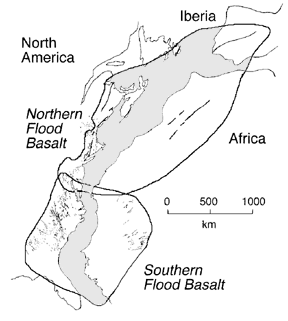HETTANGIAN FLOOD BASALTS ACROSS THE INITIAL
PANGAEAN RIFT
McHONE, J. Gregory, Graduate Liberal Studies Program,
Wesleyan University, Middletown, CT 06459-0519
PUFFER, John H., Department of Geology, Rutgers
University, Newark, NJ 07102
The original extent of Hettangian (earliest Jurassic) rift basalts can be
estimated from maps of their source dikes and of Mesozoic basins that
contain remnants of the basalts. At least two major provinces were
formed, including a northern province of relatively high-TiO2 quartz-
normative tholeiites and a southern province of lower TiO2 quartz and
olivine tholeiites. A correlation of dikes and basalts on both sides of
the Initial Pangaean Rift has been accomplished by new radiometric
dates, by stratigraphic studies of associated basin sediments, and by
comparisons of characteristic Ti, Mg, K and other large-ion elements.
The northern flood basalt province has relatively fewer but
larger source dikes, and its HTQ-type basalts still remain in basins in
northeastern North America and Morocco. The northern province
stretched from present-day northern Virginia (Culpeper basin)
northeast-ward across Atlantic Canada to include the Avalon dike of
Newfoundland, and eastward across much of modern Morocco,
Algeria, Portugal, and Spain. An area of at least 1.5 x 106 km2 is
indicated. Dikes and basalts of the northern province probably
formed within a short time span (c.6 x 105 years) between 196 and
202 Ma. Gaps in the lava sheets may be due to highs in the
Hettangian topography, and their relation to the younger ocean-crust
magmatism remains unclear.
The southern province is poorly constrained because most of
its exposed basalts have been removed by erosion. An initial basalt
cover of possibly 8 x 105 km2 was spread across the present
southeastern U.S. and conjugate areas of western Africa. An age of
c.196 Ma is likely for at least some dikes of the southern province,
although a younger age near 180 Ma has been suggested for flood
basalts beneath the South Carolina coastal plain and continental shelf.
The latter section may overlap with a portion of the ³seaward dipping
reflector² basalt and basaltic wedge at the Atlantic Ocean - North
America margin, and it should thus be almost contemporaneous with
the formation of the initial ocean crust.
Environmental problems from such enormous areas and
volumes of basalt include acidic rains and both cooling and
greenhouse effects from the liberation of up to 3 x 1012 metric tons of
CO2 and 2 x 1011 tons of SO4 aerosols, as well as considerable
amounts of halides and ash. Although the Initial Pangaean Rift
basalts appear to be slightly younger than the Tr-J mass extinction,
their possible role in such catastrophes should be assessed.

go back to "MEETING SCHEDULE"
